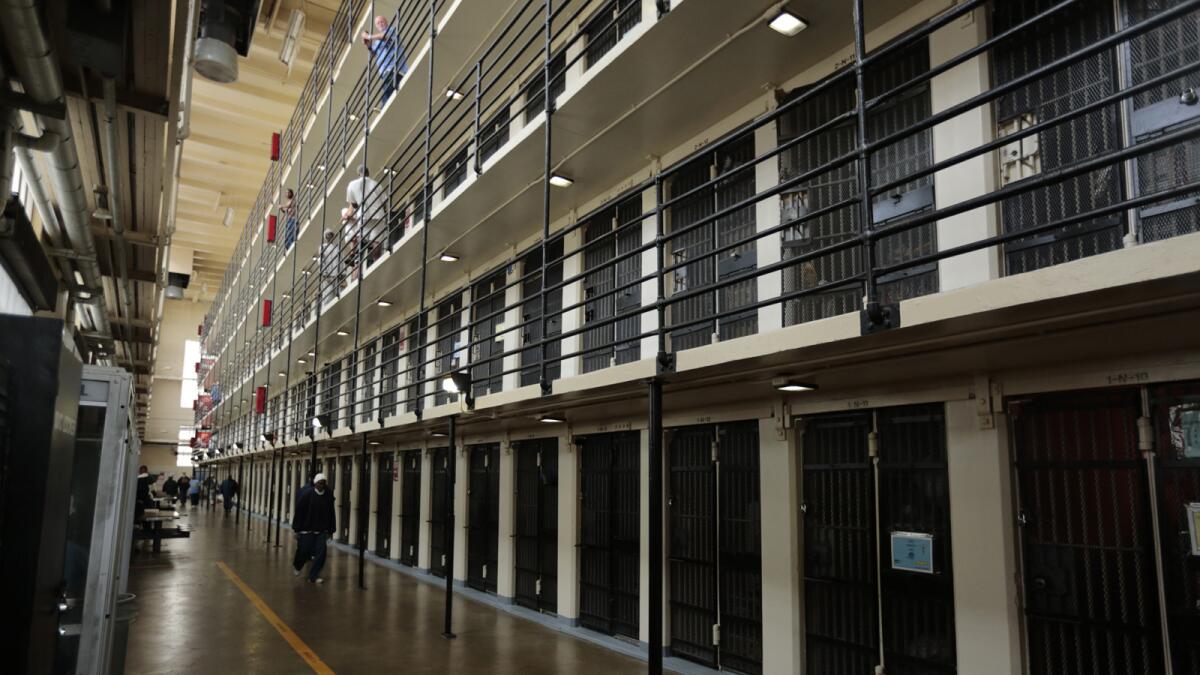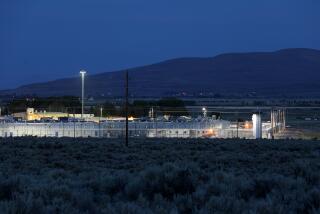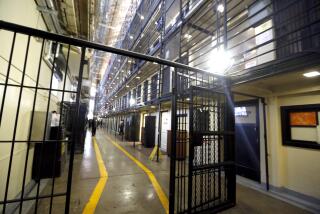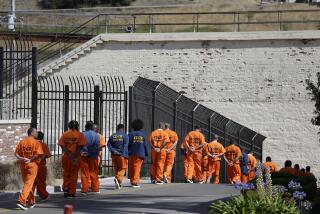California to release 8,000 prisoners in hopes of easing coronavirus crisis

- Share via
SACRAMENTO — As many as 8,000 California prisoners could be released ahead of schedule in an unprecedented attempt to stop the spread of COVID-19 inside state prisons, with more than half of the releases expected by the end of the month.
The announcement on Friday by top advisors to Gov. Gavin Newsom offered stark evidence of the dire health conditions at several California prisons. The total number of prisoners at facilities for men and women has already been reduced by thousands since Newsom declared a statewide emergency in response to the coronavirus.
More than 2,300 prisoners have tested positive for the coronavirus, state officials said. Significant increases have been reported at the California Institution for Men in Chino and at San Quentin State Prison in Marin County. At least 31 prisoners have died from COVID-19 related illnesses.
The decision to expedite the release of prisoners comes on the heels of a growing chorus of complaints by state lawmakers, prisoner advocates and a federal judge that the state hasn’t done enough to stem the rising tide of infection.
On Monday, the top medical officer for the state prison system was removed from his position following criticism of inmate transfers that are believed to have led to a much larger coronavirus problem in prisons than existed this spring. Newsom told reporters on Monday that prisoners from Chino should not have been transferred, the responsibility for which rested with the prison healthcare agency overseen by federal judges since 2005.
Officials at the California Department of Corrections and Rehabilitation said as many as 8,000 prisoners could be eligible for early release by the end of August.
“These actions are taken to provide for the health and safety of the incarcerated population and staff,” corrections Secretary Ralph Diaz said in a written statement. “We aim to implement these decompression measures in a way that aligns both public health and public safety.”
Initial prisoner releases would come from those with 180 days or less left to serve on their sentence. No one serving time for a crime defined in state law as violent or involving domestic violence would be set free, officials said. Those required to register as sex offenders or who are assessed as being a high risk for violence would also be ineligible for early release.
The second group of prisoners who could be released would have no more than one year left to serve. The releases are aimed at reducing the populations at eight state prisons identified as higher risk for coronavirus transmissions. The same eligibility rules as the first group of released prisoners would apply in these releases.
In all cases, prison officials said, priority will be given to those who are 30 or older. Prisoners under the age of 30 will be considered on a case-by-case basis.
This is not the first effort by Newsom to address the spread of the virus in correctional facilities. In March, attorneys for the governor told federal judges that the state intended to expedite the release of as many as 3,500 prisoners who were within 60 days of their previously scheduled release date. In all, prison officials say their efforts at “decompression” of California’s prison system during the pandemic have resulted in a prison population that has shrunk by approximately 10,000.
Newsom on Thursday said nearly 2,400 people in California’s 35 prisons have tested positive for the coronavirus, including 1,314 at San Quentin.
“This is serious stuff and requires a seriousness of purpose. People are just saying just release thousands and thousands of people,” Newsom said. “Each and every one of these cases are sobering, challenging, and there’s a deep responsibility that comes with this job, but a sense of deep urgency as well to decompress the system in a judicious and thoughtful way.”
Sharon Dolovich, director of the Prison Law & Policy Program at the UCLA School of Law, said state officials were warned that the COVID-19 pandemic would be devastating within the confines of California prisons. The prison system has more than 17,000 inmates considered medically high risk and, when combined with the inability to socially distance in cell blocks, an outbreak was unavoidable.
“As soon as COVID comes into a facility, it can spread rapidly,” Dolovich said. “What we are seeing in San Quentin was completely predictable and predicted by advocates at the start of the outbreak.”
U.S. District Judge Jon Tigar told attorneys for Newsom earlier this week that the virus “would inevitably invade every institution” in California and that outbreaks threaten not just prisoners, but the communities surrounding state prisons. Since the onset of the pandemic in late winter, Tigar wrote, “the disease has spread out of control at more than one institution, and the risks to elderly and medically vulnerable inmates are markedly more clear.”
Newsom’s decision to release more prisoners was not universally applauded.
Vern Pierson, the district attorney in Northern California’s El Dorado County, called it “concerning” for public safety, and said the criteria the prison system will use to decide which inmates to release remains unclear. The Newsom administration also has not made clear whether crime victims and prosecutors will be given notice when an inmate is released or if they will be able to file objections, said Pierson, who serves as president of the California District Attorneys Assn.
“We don’t know what the actual impact of this is going to be. We do know that it’s a high likelihood there will be significant increases in crime,” Pierson said.
Pierson said that because of changes made to California’s criminal justice system in recent years — including the release of many offenders whose crimes weren’t considered violent — those still in state prisons tend to be the most serious offenders.
“It’s inescapable that it’s the most dangerous people that are the people that are left in prison,” he said.
A new study conducted by researchers at UCLA and Johns Hopkins Bloomberg School of Public Health, published in the Journal of the American Medical Assn., found that U.S. prison inmates tested positive for COVID-19 at a rate 5.5 times higher than that of the general public.
“Nobody has suggested we open the door and let everybody out. I’ve never heard anybody say that,” Dolovich said. “The argument is we have to reduce a sufficient number of people so that the population density is low enough to allow social distancing for the people who remain.”
While California is far from the only state struggling with a surge in COVID-19 cases in its prisons, the threat of additional legal action recalled an era in which state facilities were overcrowded and federal judges intervened to order sweeping and expensive changes to medical care. Those judges also forced Newsom’s predecessors to take steps that would sharply shrink the state’s total prison population, a mandate upheld by the U.S. Supreme Court in 2011.
The action taken Friday could lead to as many as an additional 2,100 prisoners being released by September. State officials also offered new credits toward time served, largely to make up for prisoner programs suspended due to the pandemic. They said more reviews will be conducted for older and chronically ill prisoners and that efforts will be made to expedite the cases of those cleared for release by the state Board of Parole Hearings.
More to Read
Sign up for Essential California
The most important California stories and recommendations in your inbox every morning.
You may occasionally receive promotional content from the Los Angeles Times.












